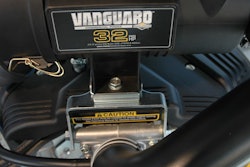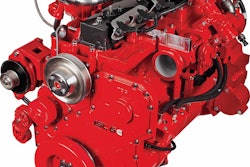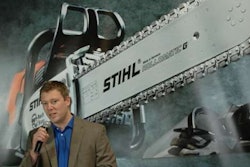 Terex’s new FDB6000 mixer truck
Terex’s new FDB6000 mixer truckDespite a “tenuous economy” and uncertainly in the marketplace, Terex Roadbuilding introduced two new front discharge mixer trucks at World of Concrete 2013 – FD5000 “Great Lakes” front discharge mixer truck and the DB6000 front discharge mixer truck.
These introductions signify a resurgence for Terex back into the marketplace and confidence of a significant rebound in the mixer truck business, which was a vibrant industry before the housing crash and subsequent recession but has been on life support as of late – as has the rest of the construction industry.
From late 2008 to 2011, the ready-mix market fell 50 percent, while the mixer truck market dropped by more than 90 percent from peak levels, according to David Rinas, director of sales and marketing for Terex Roadbuilding.
In late 2011, Terex was forced to cease new mixer and glider truck production.
David Rinas, director of sales and marketing for Terex Roadbuilding, says at World of Concrete 2013 “despite a tenuous economy,” Terex Roadbuilding believes this will be a good year for the companyHowever, prior to the economic downtown, the mixer truck business was quite vibrant and cement consumption was quite high.
During 2005 to early 2008, more than 25,000 mixer trucks were sold, Rinas says. “This was a wonderful time to be in the industry,” Rinas told editors during a Feb. 5 press event at World of Concrete 2013 at the Las Vegas Convention Center. “Mixer truck production was reaching close to 100 percent, and if you called on Monday for 40 to 50 yards of cement for house, sometimes you didn’t get it until Friday.”
But then the slowdown occurred—and did so fast and furiously. There was a drop from 25,000 mixer trucks sold during the market peak to only 4,000 sold between 2009 to 2012, 3,000 in the last two years.
“We were all just trying to survive,” Rinas said. “In 2011, we didn’t see any orders coming in. There was no light at the end of the tunnel.” The decision was made in the third quarter of 2011 to take the factory down, but with hopes of redesigning the products with new technology and new robotics, Rinas said.
“But no one had any idea when the market would come back,” he said. Still, Terex stayed focused on updating the production facility, redesigning the front discharge mixer truck and restarting the glider truck program. The Fort Wayne, Ind., facility and processes were modified to include lean manufacturing principles.
Terex trimmed the front discharge mixer line down from 13 models to six to be more efficient and cut costs. Just as Terex celebrated its 40th anniversary in the mixer truck business in August 2012, business began to start looking up.
Terex hired on a general manager for the Fort Wayne, Ind., and Canton, S.D., facilities. In the fourth
The new Terex FD5000 Great Lakes and Terex FDB6000 front discharge mixer trucks being shown at World of Concrete 2013 signify a comeback of the mixer truck marketquarter 2012, Rinas says, a significant truck order was placed. “We were getting calls about when we were going to open the plant back up, and then we took orders in July 2012 for delivery at the end of 2012. At the beginning of 2013, the floodgates began to open up. “Orders started coming in from almost every region of the country. We cautiously added to the order book in the fourth quarter 2012.”
In October-November, Terex forecast the 2013 market to be at about 120 to 140 trucks. This was reforecast in the third quarter to almost double that at more than 200 trucks, Rinas said.
“The first few steps we took were an outreach,” Rinas said Terex kept some ‘tribal’ knowledge by reaching out to the people who had worked in the design and production and also by reaching out to customers.
“We heard from customers, ‘Don’t mess with the basic truck,’ and ‘It has a good chassis so don’t change that,” Rinas noted. “Our clean sheet idea went out the window. We focused on the brake system, making the cab more comfortable and ergonomic, and powder coating and sealing the paint before parts were bolted on.”
The new trucks feature more than 100 design updates including cab and components, air, electrical and brake systems, axle configuration and steering.
Signs of the truck market rebound marked the start of 2013 front discharge mixer truck production. “We believe this will be a very strong year even with a tenuous economy,” Rinas said.
Highlights of the two new trucks include the following:
TerexFDB6000 Front Discharge mixer
- 206-inch wheelbase.
- 391-inch front axle to the to hydraulic tag axle span to meet Federal Bridge Formula standards while carrying a full load of concrete.
- Design changes to axle spacing and wheelbase has resulted in increased payload and truck profit potential.
- Standard are an 11-cubic-yard mixer drum and a 9-inch cone extension. The mixer drum is a 3/16-inch thick AR400 steel drum shell with 0.25-inch thick AR230 steel fins and flights inside the mixing area.
- Redesigned steering system, which allows the truck to take full advantage of the Marmon-Herrington front axle’s 42-degree wheel cut. This reduces the fully loaded turning radius to 68 feet, more than 23 percent tighter than previous designs. Rinas calls this a “game changer” for ready mix concrete producers.
- Also notable is that changes to the steering system design freed up 3-inches of space underneath the cab nose, resulting in 8.5-inches of additional legroom inside the cab. The cab should comfortably fit a person who is 6 feet, 6 inches tall, according to Terex.
- The lift axles are now controlled by a single lift axle control module (LACM), as opposed to four valves per axle on previous model designs.
- Additional features include a new door and latching system to prevent operators from getting locked out of the cab; hanging pedals, which include a new brake pedal that better resists corrosion for improved longevity; and a brighter LED dome light with door entry switch to improve visibility inside the cab.
- Newly designed aluminum front fenders are 28 percent thicker than previous models to increase strength and durability.
Terex FD5000 “Great Lakes” Front Discharge mixer truck
- 197-inch wheelbase, an increase compared to previous five-axle models.
- 11 cubic-yard drum with no cone extension is standard. The drum shell thickness is 3/16-inches and is constructed of AR400 material.
- Fins and flights in the mixer area are constructed of AR230 material with 0.25-inch thickness.
- New steering system that takes full advantage of the 42° wheel cut capability, resulting in a more than 20-percent tighter truck turning radius than previous models.
- Re-engineered front suspension has nearly 2.5 times more travel than the previous design.
- A 2013 EPA-compliant engine (MTU DD13 diesel engine), which can be configured to provide 350-, 380- or 450-horsepower. The mixer truck on display has a 450-horsepower diesel engine with 1,550 ft.-lb. torque.
- Some of the 20 new cab designs include the following: 8.5-inches of additional floor space; a stair rail handle and flexible hanging third step for three-point cab entry and exit; a new door lock and latching system to keep the operator from being locked out of the cab; brighter LED dome lights with door entry.
- Increased air reservoir capacity with larger tube and hose sizes and push-to-connect air fittings improve airflow through the system.
- Lift axles are now controlled by a single lift axle control module (LACM). This one valve replaces four valves per axle in previous model designs.Also notable: Trunnion rollers are now bolt-on. Drum chute cleanout area is conveniently accessed via a straight, bolt-on ladder, and covers found on previous designs have been removed.
- Also notable is that changes to the steering system design freed up 3-inches of space underneath the cab nose, resulting in 8.5-inches of additional legroom inside the cab. The cab should comfortably fit a person who is 6 feet, 6 inches tall, according to Terex. –by Tina Grady Barbaccia, Better Roads Executive Editor, reporting live from World of Concrete 2013 in Las Vegas












